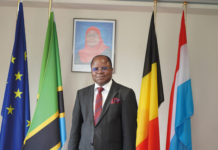Gorillas are coming … to pave the way for tourism development in Congo.
If there is an almost virgin territory in Africa, it is very likely to be that of tourism in Congo. The huge potential of one of the largest countries in Africa is almost untapped and desperately waiting to be explored.
From East to West, from North to South, Congo offers unique assets in terms of tourist attractions. As far as nature is concerned, the one that comes to mind are the mountain gorillas in the Virunga National Park. But Congo is also a myriad of national parks and nature conservation areas such as the Garamba, Maiko, Kahuzi-Biéga, Salonga, Upemba, … to name but a few.
The country is also home, shared with Uganda, to the superb Ruwenzori mountains. Add to this the uniqueness of its active volcanoes such as the Nyiragongo and Nyamuragira, one of the few places on earth where one can witness the power within our planet!
The Congo river, together with its tributaries, are absolutely untapped assets for development as it could offer various options for river cruising from the luxury of a five star ship up or down the river. Smaller rivers are waiting to be explored by the more adventurous using a variety of power boats or even dug-out canoes.
The equatorial rain forest is yet another dimension to be explored by visitors with its unique ecology and home to the roots of so many different cultures.
Even though the country doesn’t really boast seaside beaches, one should not forget the beautiful lakes of the rift valley to the east of the country, many of which, lake Tanganyika ahead, could offer a relaxing touch to any holiday that has nothing to envy the sandy beaches of any ocean.
Another huge asset of Congo lies in its cultural richness, both contemporary and traditional. Music has always been a great Ambassador to the nation, but there is much more than that in Congo that is waiting to be exposed and revealed to the rest of the world. Looking at the traditional side of things, Congo is perhaps one of the very few countries in the world to offer such a variety of cultural group who keep their traditions alive.
If nature conservation can rather easily benefit from tourism development in an harmonious way, things are quite different when it comes for a nation to invite visitors to witness and experience its traditional cultures. If not developed with thought, this is probably where tourism pollution has the worst and most non-reversible impact. A glimpse at the disaster of what happens in the Omo Valley should serve as a clear example of how wrong things can go. When it comes to discovering other cultures, we believe it is important to allow sufficient time while guaranteeing a lot of privacy.
In a world where experiential travel has become the new trend, the above assets are setting the perfect scene for Congo to develop its tourism industry in a way that involves and benefits its population directly.
Obviously the various crises and wars the country has experienced are contributing to a challenging image which keeps tourists – a rather shy and easily frightened “species” – at bay. We believe that it is the government’s mandate not only to ensure a real welcome to visitors while guaranteeing their safety during their visit but also to work hard at promoting a positive image of the country around the globe.
It is almost unthinkable that Congo, which is full of actual tourism potential, could not be part of the leading tourism destinations in Africa.
Although the subject has been repeatedly covered by the media around the world, and without stating that it is the only solution possible, we want to briefly put the spotlight on the Virunga Alliance project dedicated to managing the Virunga National Park, one of the oldest in Africa, which proves all is possible.
Recognized as a UNESCO World Heritage Site, the Virunga National Park covers about 7,800 square kilometers and is probably the African continent’s most biologically diverse protected area. From a tourism perspective, its main attraction and key drawcard remains trekking to encounter the mountain gorillas of which the park hosts about a quarter of the remaining population worldwide.
What makes the Virunga Alliance project really interesting – and perhaps an excellent example of what it takes to implement a real sustainable dimension in a rather economically and socially challenging environment – is its integrated vision of development over the years.
Born of a Congolese commitment to the protection of its national park, the project embraces a responsible economic development of its natural resources to the benefit of the surrounding population. With about four million people who live within a day’s walk from the park’s borders, its ultimate goal is to foster peace and prosperity in the region through poverty reduction without which long term sustainability would be jeopardized.
In addition to its primary mandate dedicated to the conservation of nature, the Virunga Alliance project has achieved great results through its vision that invests a minimum of 30% of the national park’s revenues in community development project. Looking at it from a different perspective, one could state that the Virunga Alliance lays at the intersection between nature conservation, civil society, private sector and state institutions working together toward delivering large-scale opportunities to tens of thousands of Congolese men and women who are ready to rebuild the region and redefine their future.
The development of tourism in the Virunga National Park would not be viable unless the local community adheres to it – which could only be achieved with an improved quality of life resulting from it as well as the improved job prospects.
One can already state that the park is a major driver of peace and prosperity in the region, and … in a certain way … the mountain gorillas, are paving the way for tourism development in Congo, certainly one of the countries with the greatest potential in Africa!
And – in a certain way – thanks to … the mountain gorillas!
![[:en]gorrile[:]](https://perspectives-cblacp.eu/wp-content/uploads/2017/07/gorrile-696x392.jpg)


